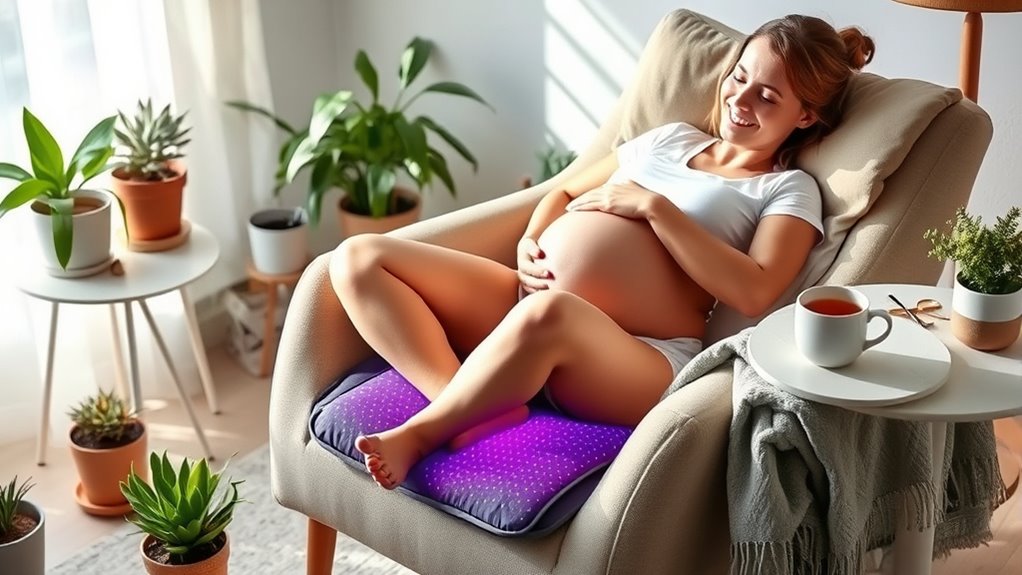Pregnancy can bring joint pain as hormonal changes, weight gain, and fluid retention create discomfort. To ease this, try low-impact exercises like swimming or prenatal yoga. Using supportive footwear and practicing proper body mechanics helps reduce strain on your joints. Heat and cold therapy, prenatal massages, and physical therapy can also provide relief. If you’re looking for more ways to manage your discomfort, plenty of effective strategies can help you feel more comfortable during this special time.
Key Takeaways
- Engage in low-impact exercises like swimming and prenatal yoga to relieve joint pain and improve flexibility.
- Utilize heat and cold therapy to reduce inflammation and alleviate discomfort in painful areas.
- Consider prenatal massages to ease muscle tension and enhance circulation, providing relief from joint pain.
- Wear supportive footwear to minimize stress on joints and improve overall comfort during pregnancy.
- Practice proper body mechanics and take regular breaks to stretch, preventing stiffness and enhancing mobility.

Pregnancy can bring a lot of changes to your body, and joint pain is one common issue many women face during this time. As your body adjusts to the growing baby, hormonal changes like relaxin and progesterone lead to ligament relaxation, causing joint instability and discomfort. Weight gain also puts additional stress on your joints, particularly in the lower back, hips, knees, and ankles.
Pregnancy brings significant changes, often leading to joint pain due to hormonal shifts and added weight stress.
With your center of gravity shifting due to the growing uterus, it’s no wonder you may experience strain in these areas. Fluid retention adds another layer, increasing pressure on your joints and exacerbating the pain.
The lower back is often the most affected area, primarily due to weight gain and postural adjustments. Hips frequently ache as hormonal changes impact your body’s weight distribution. Your knees may feel stiff and painful, especially with the added weight and swelling.
While joint pain can affect your hands and wrists, it tends to be less common than discomfort in your lower back and hips. Similarly, your ankles and feet may experience swelling and pain as your body copes with these changes.
Symptoms of joint pain during pregnancy can include pain and stiffness in the affected areas, limited mobility that makes daily activities challenging, inflammation due to fluid retention, and instability from hormonal fluctuations. Muscle tension often accompanies joint pain, as your body adjusts to new postures.
Fortunately, there are safe treatments you can explore to ease this discomfort. Physical therapy can offer tailored exercises to strengthen your muscles and improve flexibility. Heat and cold therapy can help relieve inflammation and pain, while acupuncture is also a safe option to consider.
Prenatal massages can alleviate muscle tension and improve circulation, and chiropractic care might help restore joint alignment.
Incorporating lifestyle changes can also make a big difference. Low-impact exercises, like swimming and prenatal yoga, can alleviate pain while keeping you active. Maintaining a healthy weight reduces stress on your joints, and practicing proper body mechanics improves posture.
Supportive footwear is essential, too, as it helps reduce joint stress. Regular breaks for stretching and moving can prevent stiffness.
Joint pain can impact your quality of life during pregnancy, making daily tasks more difficult and emotionally taxing. It’s important to seek support from healthcare providers and loved ones. Consulting with them about your symptoms can help you find personalized advice, while support groups can provide emotional relief and shared experiences.
Frequently Asked Questions
Can Pregnancy Joint Pain Affect My Ability to Exercise?
Yes, pregnancy joint pain can definitely affect your ability to exercise.
You might find that joint stability decreases, making certain movements uncomfortable. As your weight increases, exercises that put stress on your joints may become more challenging. Hormonal changes can also lead to joint laxity, complicating your routine.
However, by adapting your exercises, like opting for low-impact activities, you can still maintain a regular fitness routine while managing discomfort.
Are There Specific Foods That Help Reduce Joint Pain During Pregnancy?
Ever wondered what foods could help ease joint pain? Incorporating anti-inflammatory foods like salmon, leafy greens, and berries into your diet can make a difference.
Omega-3 fatty acids and antioxidants fight inflammation, while calcium and vitamin D support bone health.
Don’t forget to stay hydrated and avoid processed foods that can worsen pain.
When Should I Consult a Doctor About Joint Pain?
If you’re experiencing joint pain, it’s crucial to know when to consult a doctor.
You should reach out if the pain persists or worsens over time, interferes with your daily activities, or affects your sleep.
If you notice reduced mobility, fever, redness, or swelling, don’t hesitate to seek medical advice.
Additionally, if the pain is localized to specific joints, specialized care might be necessary for proper evaluation and treatment.
Is Pregnancy Joint Pain Common in All Trimesters?
You might feel a twinge in your back, then a sharp pang in your knees, wondering if it’s just you.
The truth is, pregnancy joint pain isn’t uncommon across all trimesters. Many women experience discomfort as their bodies change, especially during the second and third trimesters.
With hormonal fluctuations and added weight, joint pain can intensify, affecting your daily movements.
You’re not alone—many share this experience, often seeking ways to find relief.
Can I Use Heat or Ice for Joint Pain Relief?
You can definitely use heat or ice for joint pain relief.
Heat therapy, like a warm towel or heating pad, relaxes muscles and increases blood circulation. Ice packs or cold compresses numb pain and reduce inflammation.
Just remember to limit each session to 15-20 minutes for heat and 10-15 minutes for ice, taking breaks in between.
Always consult your healthcare provider before starting any new treatment to ensure it’s safe for you.
Conclusion
In conclusion, managing pregnancy joint pain is crucial for your comfort and well-being. Just like a gentle breeze can soothe a sweltering day, the right strategies can ease your discomfort. Remember to prioritize rest, stay active with light exercises, and consider gentle stretches to keep those joints happy. Don’t hesitate to reach out to your healthcare provider for personalized advice. By taking these steps, you can enjoy this beautiful journey with less pain and more joy.









